#comic tips
Note
Hey what tips do you have for speech bubbles in a comic
A few, let’s see what I can come up with.
Okay number 1: If you are doing any kind of comic, DO THE TEXT BEFORE THE BUBBLE! Do not ever draw a bubble and then try to cram three long sentences into it. It doesn’t look good and the text ends up being illegibly small. Example:
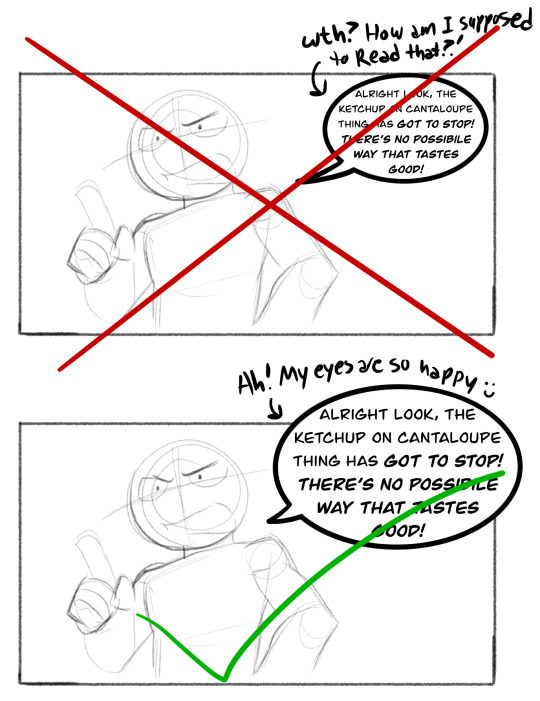
-
Number 2: IT DOESN’T HAVE TO BE ONE BUBBLE! Sometimes when you’re character has a very long dialogue segment or you want there to be an audible pause, you can break their dialogue into pieces connected by tails.

This is a good tool for making sure people actually read the dialogue. A lot of people (myself included) have a subconscious reaction to big blobs of text that makes them want to skip it or just skim it. By breaking the long exposition into smaller chunks, people’s brains won’t see it as a ton of effort, and will remain focused on the story, even though it’s literally the exact same number of characters.

This works because of the way we perceive time in a story. Because I want this scene to feel like a slow tense moment, I split the dialogue so it takes longer for the reader to read the dialogue and thus, feel as though this moment is longer.
Number 3: PLAN FOR YOUR SPEECH BUBBLES! This is something I have had to learn the hard way! Do not draw the picture and add the speech bubbles later. The way you draw a picture without speech bubbles and with is very different. Example:
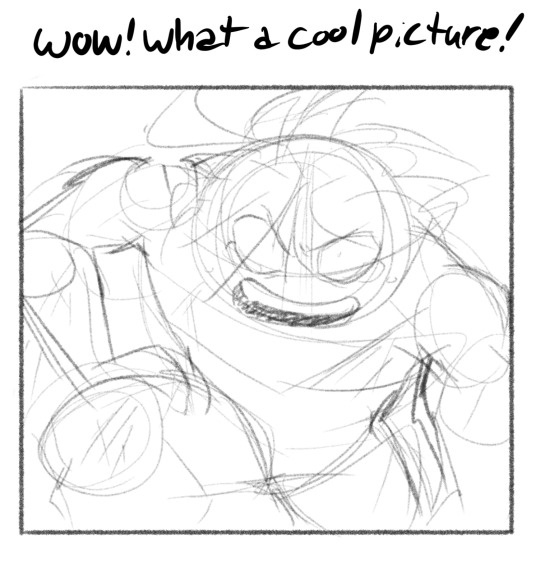
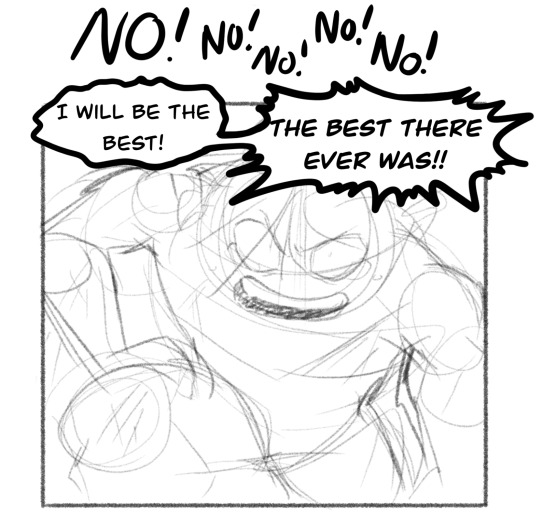
This is not good! The speech bubble is cutting out your picture! Now, everyone does their speech bubble differently, I do mine at 90% opacity, some don’t do any bubble and just draw the speaker’s tail, but many do 100% opaque speech bubbles and this is not good! How to fix it:

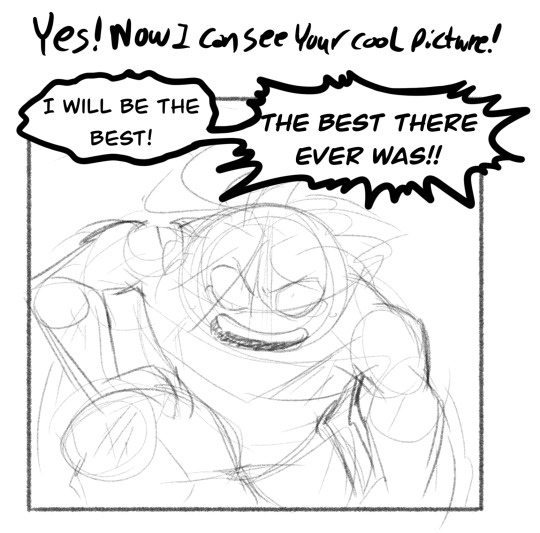
Plan where your speech bubbles will go and purposely leave empty space there or something that you don’t care about as much, like the tips of their hair, or their bandana tails, or the end of their scarf, etc. Just make sure that your image is small enough that you can still see it with the speech bubbles on top. If you can’t shrink the image enough to fit it and the speech bubbles, then you need to consult rule 2.
Alright, I think that’s it! As a recap: Do the text before the bubble, The text doesn’t have to be in one bubble, and plan for your speech bubbles!
Hopefully you found this helpful, if you have any further questions, I’d be happy to help!
Good question! :]
574 notes
·
View notes
Note
if i may ask, is it difficult at all to re-edit/organize the comic pages from the webtoon format to fit the graphic novel format?
on another note, I'm so happy that your kickstarter was funded!!! I love time and time again, im so excited to see this all happen <3
I'll just turn this ask into something of a guide for the process! Because yes, it is difficult, but there are also many ways I have been preparing from the beginning for this very situation to make things easier for me!
I've worked in both print and scroll in the past, and have done this transition once before for a short story, so I already had familiarity both with my goals for print, and struggles with the transition!
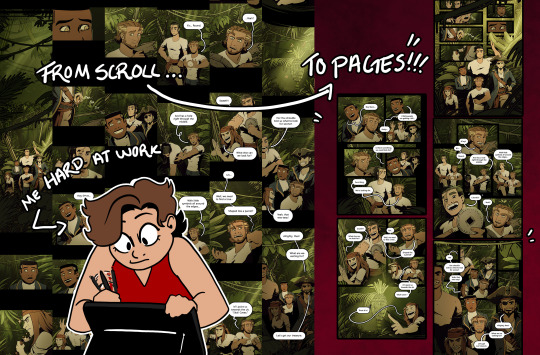
How I prepared from the beginning for this transition:
1: My panels are 2500 pixels wide, so they can span my page (which is 8.3x5.8 inches) at 350 DPI (which is print quality)
2: My layers are organized: Text, FX, Foreground, Characters, Background

3: I draw one very large (twice as big as any panel would be, minimum) background for my major locations, as well as drawing furniture assets in isolation. This not only saves me time when making my actual episodes, but it also offers me INCREDIBLE flexibility when making this transition to print.
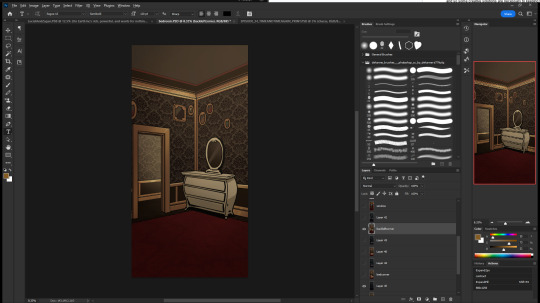
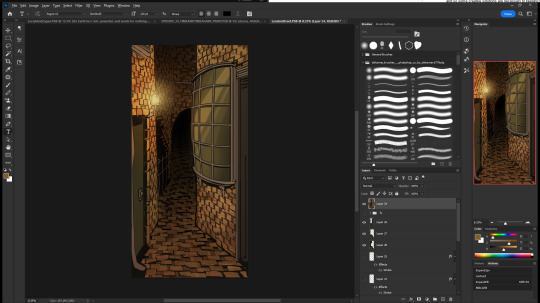

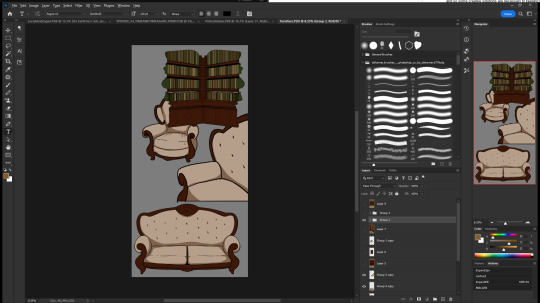
These 3 things let me pull the character art to the page by itself, scale it up or down to fit my panel, and then fill in the background behind the character.
So, I read the scroll version, decide how many and which panels I want on the page for the pacing (I also keep page spreads and page turns in mind while I am doing this), and then I pull those panels over from the scroll version to the page.
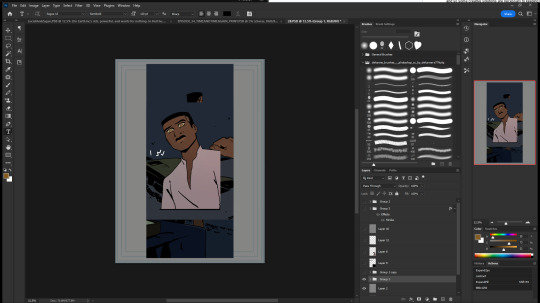
Then, I make the panel borders/page layout that I want, fit the character art into it, paste in the backgrounds, do any art editing that I need, add FX, and then re-do the text!


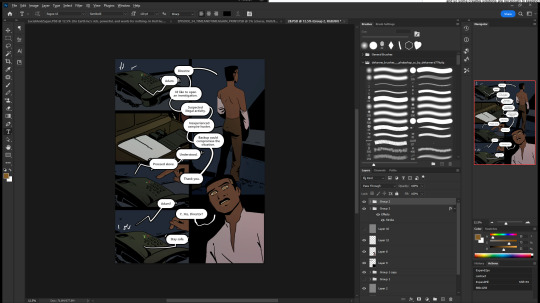
Sometimes I do need to draw parts that are missing (shoulders or elbows getting cut off is an extremely common one) and sometimes I need to adjust facial expressions, cut panels, or rearrange panels to make things read more clearly. Since it's my comic already, I know how to do these things while maintaining the original intent, but if I were working with someone else's comic I would need to work closely with them to know what can and can't be cut.
(original panel vs an expanded version)
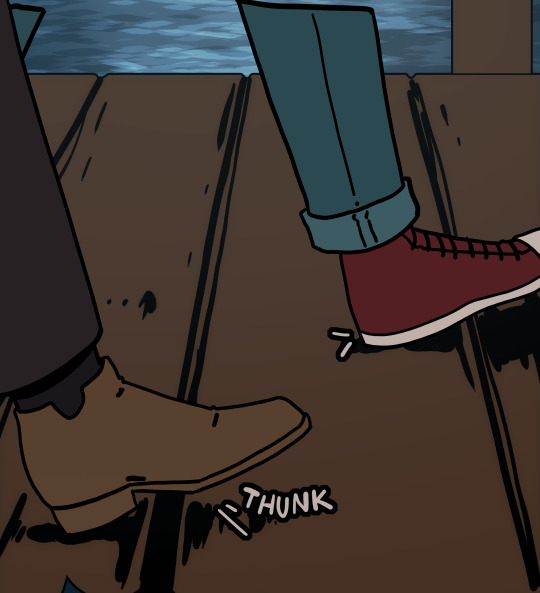
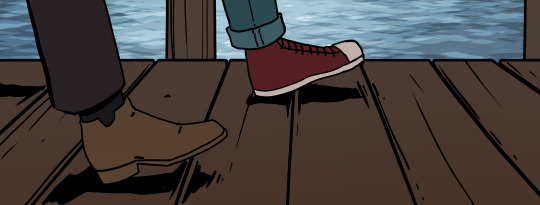
Another common issue is that VERY tall panels will inevitably lose a lot of information when they’re turned to pages. Identify the purpose of the panel (pacing, showing a lot of detail, etc) and then replicate that with your page layout.
examples (in order) are: scene transition, being overwhelmed, suspense, and establishing shot. All of these were a single panel in the scroll version!


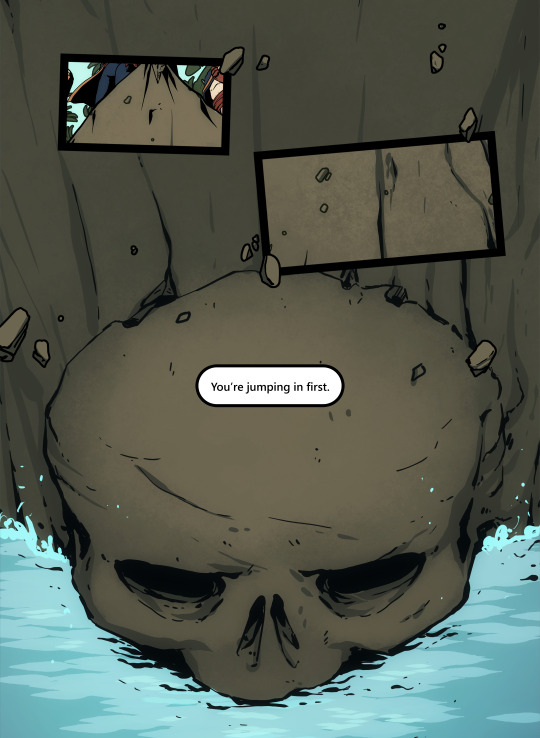
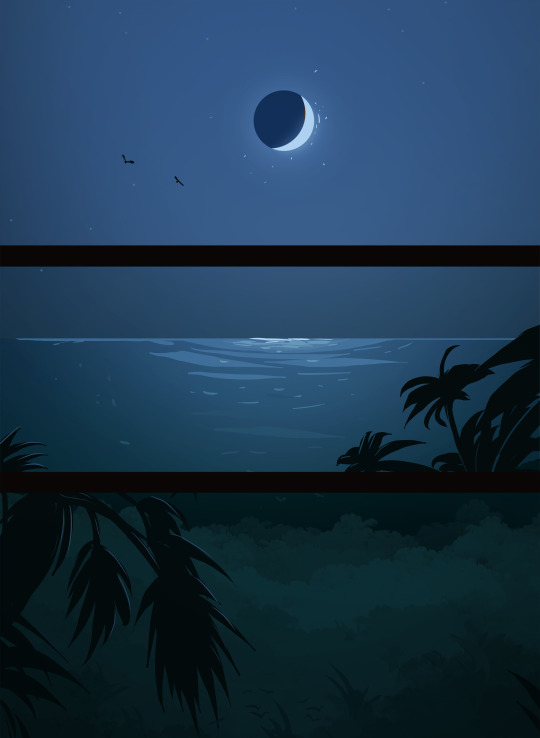
Another issue when converting pages is that panel order is a lot less straightforward than when starting from print format. Conversational back and forth that's fine in scroll often messes up the flow of reading in a page (characters facing out, not looking at eachother from panel to panel, etc) and so some creative solutions are necessary to keeping the reading order.
For the first page I had to delete and rearrange some panels, and in the second the dialogue bubbles guide us to read this page in a circle. (dialogue guides through a lot of my pages lol)
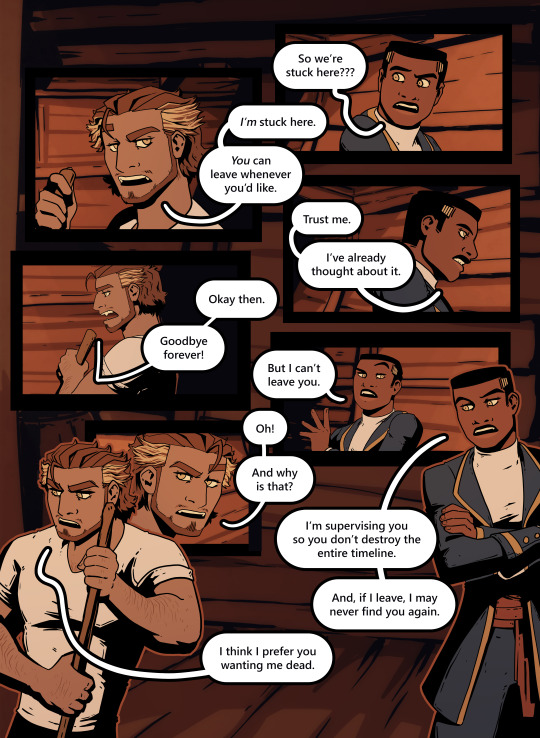
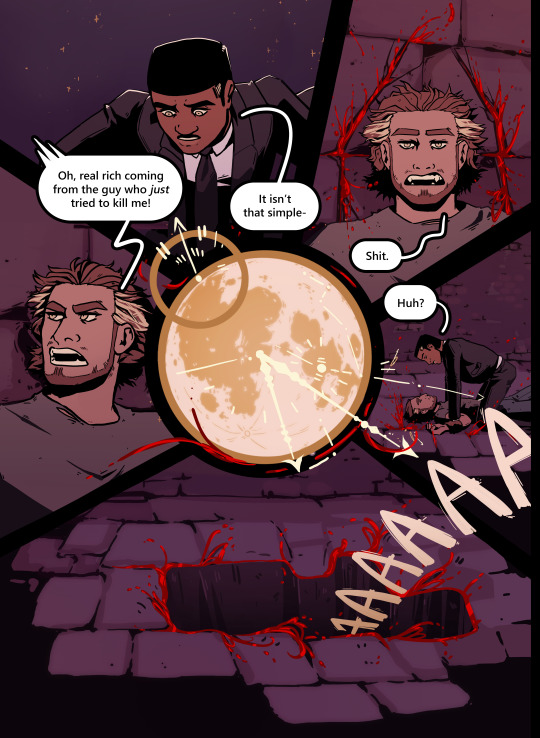
And the last really common issue that pops up is that height differences can be really difficult. Usually in print this is solved with clever angles, but I’ve already drawn everything. So, I’ll either resort to vertical shaped panels, panel pop-outs, or editing a character up or down to fit into the panel.
(examples in order)
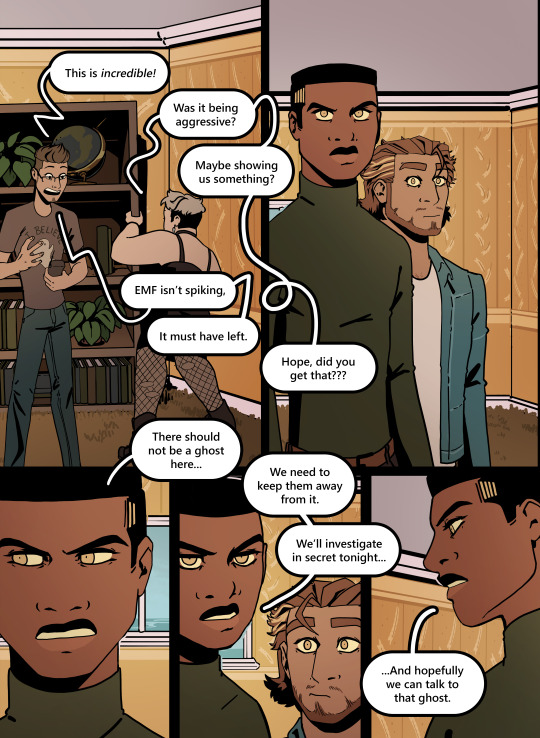
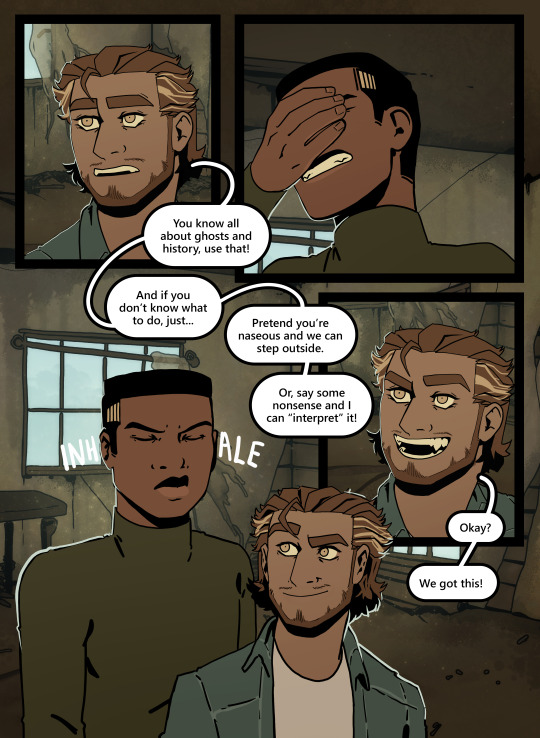
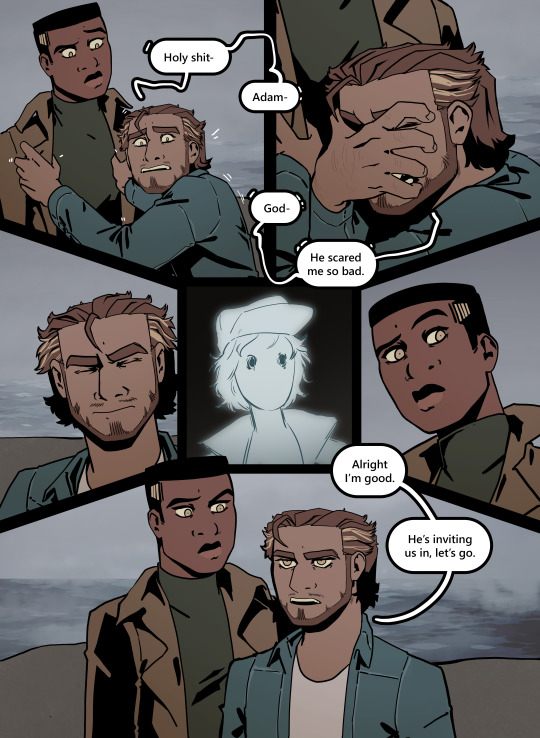
So, yes, it is difficult! But I have a lot of experience with both formats, and having prepared for this from the beginning I've been able to make the transition a LOT more smoothly than I otherwise could have.
I hope this helps!
And, thank you about the kickstarter! I'm extremely excited I'll be able to print these, the proofs I've received so far look just absolutely stunning and I'm so so so excited to get to send them to people!!!
Obligatory self promo, if you want to see the kickstarter page and get these four books for yourself, then you can check it out here ^^ It's been funded, so at this point we're just reaching stretch goals and placing orders!
#asks#anon#art tips#comic tips#web comics#comic books#comic advice#also this is just my own experience obviously everyone works differently and I cant promise this will work for you too#but doing things this way I've been able to finish about an episode (15 pages or so) every day#so it's been extremely swift (though also of course a ton of work)#thank you past me for making this so easy!!!#it'd easily take 5x as long without the prep I did!!!
165 notes
·
View notes
Text
I have learned how much more easier and better it is to plan shots in panels by laying out the area your characters are in, because like, you KNOW where shit is
Just do like, a simple floorplan of the area, at the very least, and it helps a million, I swear
Like this, doesn't have to be as in depth but it helps fr
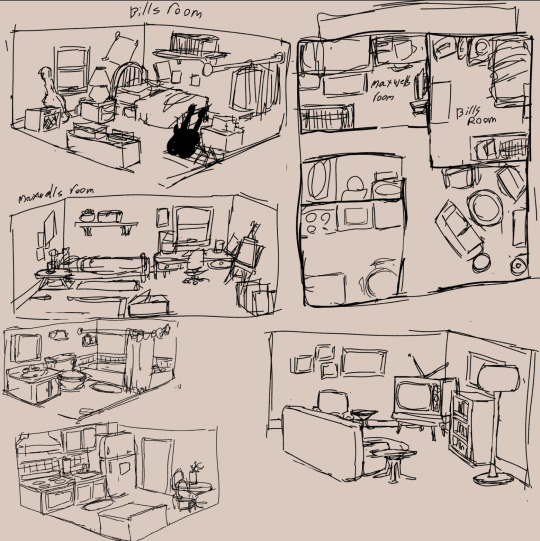
#art#drawing#artists on tumblr#small artist#artist#my art#web comic#comic art#comic artist#art advice#drawing advice#art tutorial#art tips#drawing techniques#drawing tips#drawing tutorial#comic tips
116 notes
·
View notes
Text
Tips on Pacing
We, as creators, seek that hook that gets the readers invested and keeps them that way. Nothing does that better than tension. There are all kinds, but it often occurs between characters. The "do they like me" of romance, the interruptions of erotica, the intense adversary from an unknown opponent, or the whodunits of mystery; Tension comes in all shapes and sizes, but it boils down to one thing, leaving the readers holding their breath in anticipation of the next page.
A large part of the creative process is figuring out how to create that tension without leaving the readers wanting to quit out of frustration or confusion. I would like to say there is a correct way to pace things, but it depends entirely on the story and situation.
Action scenes, for example, move very quickly, whereas a scene with a lot of dialogue will move at a snail’s pace. A spicy scene will emulate real life, moving slowly at first and increase its pace. A dramatic scene can be either fast or slow, depending on what it contains.
There are the peaceful scenes that do not move the same as any other kind of scene, showing the contentment of characters, the sun setting, or moving from one place to another. In writing or showing these scenes in a comic, it will go very quickly but the reader will perceive them as slow.
Showing a car ride, or a cooking scene allows characters to reflect on what has been happening and offers character development, but it does not have that tension at all. Still, adding those scenes is like adding bread to your butter. Now, everyone has their own tastes, but I would find it very odd to find someone who would consume just butter, especially if it was unsalted. Adding those peaceful scenes makes the ones that aren’t, all the more impactful, to both your readers and your characters.
The calm before the storm does wonders in storytelling, but the one thing you want to avoid is spending too much time in that calm. An example of this would be The Hobbit. Now, I love The Hobbit. It’s a classic hero’s journey, with a deep world build and rich characters, but parts of it are unnecessarily wordy. There is a page that describes the moss on the trees in such detail that you can taste it, which shows Tolkien’s skills as a wordsmith, but it was ultimately padding.
waits for the rage.
Padding; words that don’t move your plot forward and only add to your word/panel count. Padding or filler should not be confused with peaceful scenes. Peaceful scenes will add to your story, padding will not. The literary world has changed a lot since Tolkien wrote The Hobbit, and we can see that evident in modern literature by the fact that there would hardly be a mention of trees at all, let alone the moss that grows upon them.
The next subject of pacing is sentence variation and flow. Now, flow is a tricky subject, and is not often resolved during the initial draft. When I am editing, things will sometimes be in the wrong order and disrupt flow. When flow is off, tension wanes, and when tension wanes, readers will lose interest. There may be entire scenes that I think don’t work where they are, but rather than delete those scenes, I find a place where they fit better. Perhaps that place is earlier, perhaps it is later. If you thought that scene was necessary when you wrote it, perhaps there is a proper place for it.
In A Galactic Star, a part of the chapter titled Repercussions, was supposed to happen right before the climax. I moved it up to allow the reader to understand Chrome’s hesitations between him and Neon.
Even in comics, you aren’t going to necessarily catch things after you just completed them. Many indie creators will recommend a space between writing the initial draft and editing it. The amount of time varies per person, but it is suggested to at least give it a day. The reason is because of the completion high; You just created this thing and in your mind it is amazing and awesome, not seeing the mistakes that are there. I feel as though editing is like polishing a stone; Every stone, no matter how grey or plain in appearance, can be polished into a stunning masterpiece if given enough time.
The editing process has multiple phases, the first is checking for spelling and grammar mistakes, and the second is checking the sentence structure for flow and repeating these steps as necessary. Example: The loud dog barked. Vs. The dog barked loudly. The first is grammatically correct but makes you pause to process, whereas the second will allow you to move on to the next sentence without that stop.
Flow is a key component in pacing, which is a key component in tension, which keeps your readers engaged. As a potential reader of your story, I hope this will help you to bring it to life.
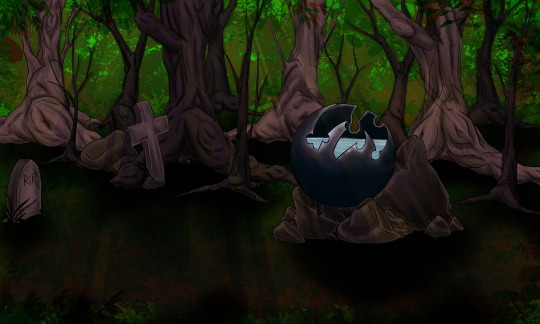
#writing#creative#writers#writers on tumblr#fiction#writeblr#novel writing#comic writer#writerslife#writer problems#writerblr#writing tips#writing advice#writer tips#pacing#storytelling#comics#comic tips#story writing
723 notes
·
View notes
Text
As requested I’ll share some of my comic making knowledge. Keep in mind that I’m not a professional and have been self taught when it comes to making comics, SO take my tips with a grain of salt. Also English is my second language, I dont know some words.

First of all I think a very useful thing you can do is study film, especially how shots are designed. The way film makers decide what is in a specific frame is very similar to deciding what should be in a panel, and in general improve your visual language skills.
Still, comics are a different medium and have different advantages and disadvantages to keep in mind.
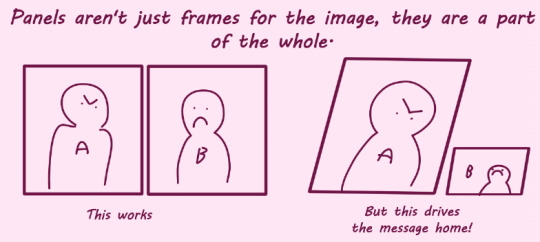
Second thing I wanna share is that often there’s a lot more thought put into what is inside the frames and not the frame itself, when they should work in harmony. In the above example are two versions of the same exchange, where character A is making character B upset. The first works, but lacks impact, while the second one uses visual language tricks like being bigger and leaning over the other to show who is in charge.
Now, the first example might work better in different scenarios, it’s less about what’s always right and instead about knowing your options.
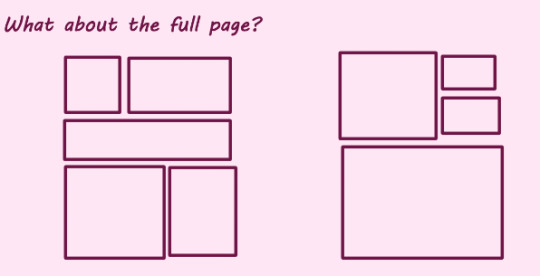
I recommend dividing a comic page into two or three segments, any more will be cluttered. Clutter CAN be very useful to drive home a joke or a sense of anxiety, but most of the time I’m guessing you arent doing that.
But what’s also important is to not necessarily use stock page layouts. There are only so many ways you can put squares on a bigger square, but you need to understand what each square can bring to the table.
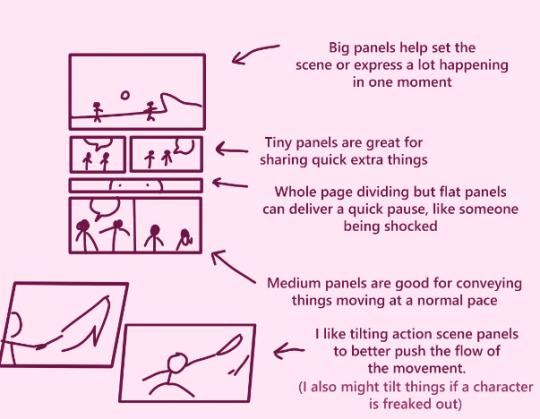
I’m sharing some general tidbits, but remember that when you start learning the rules, you also got to learn to break them when appropriate! If you want to show how ineffective an attack is, maybe dont give it the flair of a cool panel. If you want to have a big panel full of small snappy speech bubbles to express a group chat kind of conversation vibe, why not! Experiment!

Finally what’s better than learning from the real deal. I’m gonna show off my own stuff here, but remember that the more varied your study topics the better. Look at manga, western comics, newspaper strips, all of it and see what you like and dont like in them! Or how they approached something you want to tackle.

Full comic here
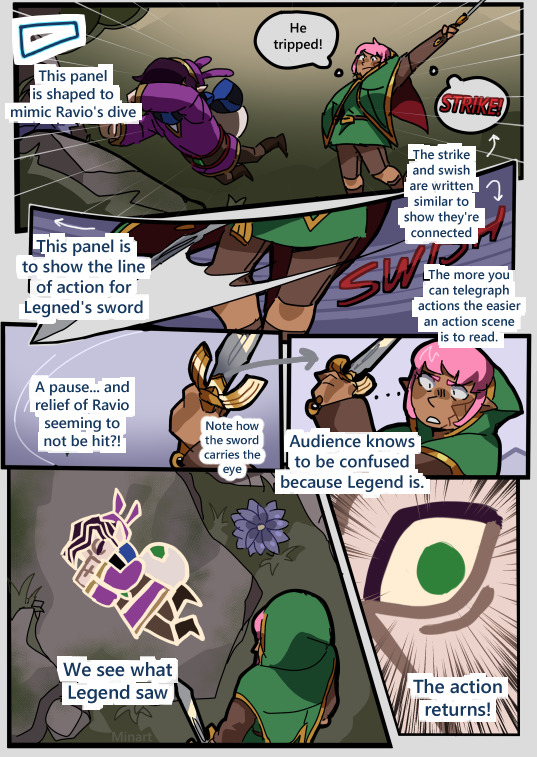
Full comic here
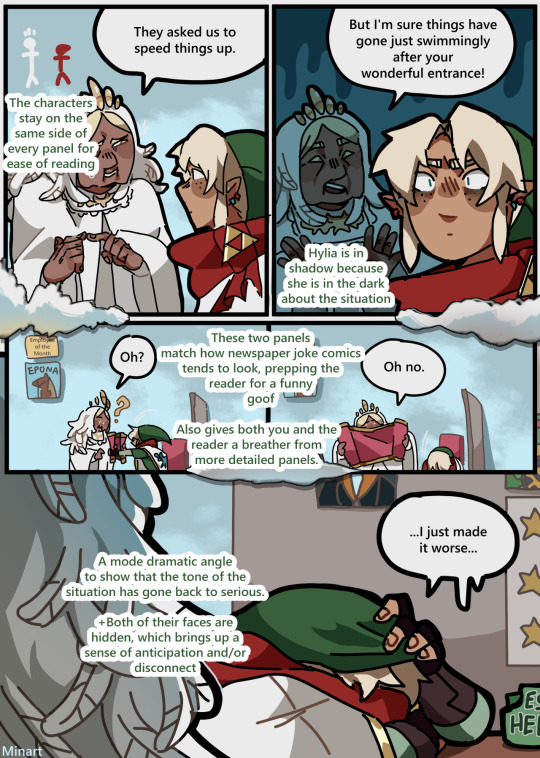
Full comic here
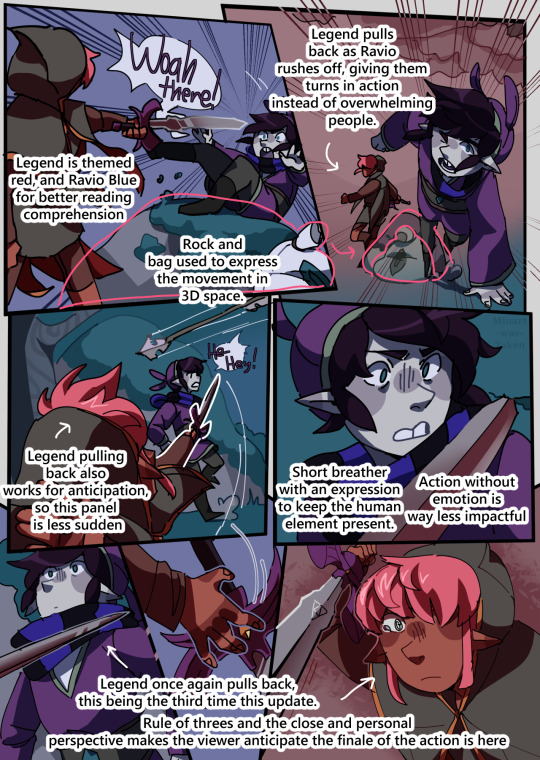
Full comic here
I just noticed a bunch of spelling mistakes oops. That’s other people’s problem now, I can’t be bothered.... 😭
So in conclusion, focus on making things readable, visually interesting, and have fun or smth. If you are doing things correctly, each element should feed into each other. Visual interest should help in clarifying whats going on, and so on.
PS. I didn’t include more basic tips like how to make panels that flow in the right order, or the fact that level of detail and line thickness can tell whats in the foreground and whats in the bg. Consider this more of an encouragement to study things, and less of a full tutorial.
1K notes
·
View notes
Note
When you make a comic how do you make one as a beginner like is there a way that I have to do it or do I just do it normally how I draw (I just need some help with it because I'm making a comic series 🥲)
I'll try my best to explain it here (I'll have some videos hyperlinked at the end)
Drawing comics as a beginner definitely takes a lot of time, and there's a lot to think of when it comes down to making one. It's very easy to say "just do it," and in most cases, it really is just jumping in and just doing it.
What I will say is, if it's a series that has an end goal in mind, it's always good to figure out the story first and plot an outline on what's going to happen. If there isn't, and it's more of a slice of life/no overarching plot, don't worry about too much scripting or planning (and just have fun with it).
Writing a script also helps so you can plan what the characters are saying/doing.
Some examples of how i usually script (Freaky Friday and another original comic project I have planned)


(Doesn't have to look like mine, but it helps you get a visual for what you want said/done)
I found that making comics is that I kinda just learned as I went along, even if I wasn't 100% good with drawing certain things like perspective or backgrounds. You'll be forced to draw things you dont like or aren't good at, but with practice, you'll get there.
There isn't a specific way to make a comic at all since everyone's work flows are different, or they change based on what they need.
My usual workflow is basically:
Story plotting > writing > storyboarding/sketching > drawing > coloring > final rendering (optional/depends on style)
You might have a different drawing process, and that's fine. As long as you're comfortable with how you do your work, there wouldn't be much of a reason to change it. If it's causing frustration, it's always good to switch it up to find what suits you.
My advice is to just try to find a workflow that fits you best and see how long it takes to do a certain number of pages, like 5 pages within 5 hrs as an example. I watched a lot of YouTube videos on tips
Here's a pretty short playlist to introduce beginners to comic making tips
#also be sure to take breaks#(<- needs to take my own advice)#art advice#(i hope it helped)#ven speaks#comic tips#ask
21 notes
·
View notes
Text
youtube
Not exactly writing, but an art tip for my webcomic creator followers :)
#webcomic#indie comic#comic#comic advice#comic tips#art advice#art tips#rightwriter#youtube#manu mercurial#Youtube
45 notes
·
View notes
Text


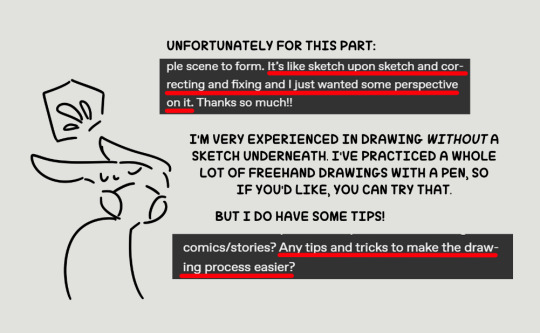




237 notes
·
View notes
Note
Howdy howdy!!!
I am not sure if this question was ever answered but I am curious about the comic resolution you use! I use Procreate so I am not sure how it translates to other program you use.
My comics come out slightly blurry when I post the pages, but when clicked on it clears up.
Thank you!
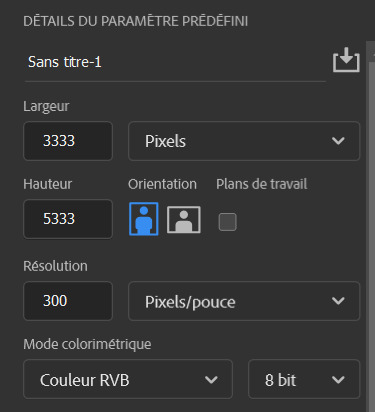
Page size has evolved quite a bit, but since I started working on Photoshop, these are the settings I use! In French, but you get the idea, it's 3333px(width) by 5333px (height) with a resolution of 300.
If your pages still come out blurry, you should make sure you export them as PNGs. JPEG tends to mess up quality badly.
And if that still doesn't help, then it might just be the Tumblr curse *sigh*.
#ask#ask me#comic tips#my settings are a bit absurd lol#but I got used to it so it stays haha#you're welcome! good luck
31 notes
·
View notes
Note
Hi Pix!! How are doing? I wanted to ask.... Is there any advice you could give me about writting a comic? I want to make a comic but I just don't know how to start writting it and it's driving me crazy... I hope you're having a nice day!
Hi hello! I can share some tips of my whole drawing process hopefully that helps ;w;)b
So I guess I start by writing down any idea I have and then I write the dialogue down on my notes

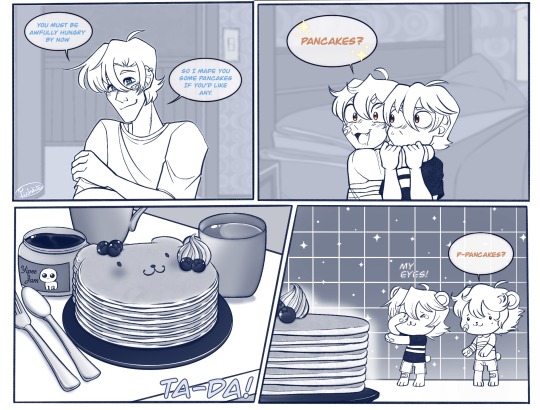
I don’t always keep the dialogue the same tho because once you start drawing it out you want to add or take away stuff then maybe also make some jokes or change the expressions or reactions so sometimes the dialogue is just a sort of base to help you start drawing something and keep the ball rolling y’know?
This is also not necessary but sometimes making a drawing or speech bubble pop out of a panel just makes it more fun >>

Also might help with perspective a little make it more pleasing to the eyes I think ;w;
And tbh? Just using lots of references? maybe saving cartoon or manga panels or even screenshots of a show you like to use to redraw for practice or give you an idea of what to draw helps a ton ฅ(≚ᄌ≚) even some other artists might give you an idea of what to do >> tbh I learned to use gradient or patterns in backgrounds from artists I follow here and some sonic comics like IDW or Steven universe 👌 so yeah ;v; have fun, stay hydrated and save those refs 💖 goodluck with your comic, I’m sure it will turn out amazing 💖💖💖
67 notes
·
View notes
Note
ello mera,
I wanted to ask how you post your comics online because i was thinking about making my own web comic series but i dont know where to start hehe
I think the website you used for IBWR was called Hiveworks but im not to sure how it works...
Also if you have any other tips when it comes to making comics like time management, planning, or even how draw those gorgeous backgrounds, it would be much appreciated :D
Thank you for your time ヾ(•ω•`)o ✧.*
Sure thing buckaroo, get in the backseat and let's hit the comic road!
ヾ(•`ω´•)o ✧.*
this is all from my perspective though, some stuff may not work for you, but hey - no knowledge is bad knowledge.
Hiveworks is a... Publisher! of sorts! Kind of. They're not like webtoons or Tapas when it comes to comic hosting, you have to be invited to Hiveworks (like me!) or apply to join them! :)
They also have Hivemill which is a place where they sell merch for the comics. Either Hiveworks helped making the merch, or the artists themselves made the stuff and Hiveworks helps distribute it (I THINK, don't quote me on that. I haven't made or sold merch with them before. But it's what I understand. They have explained it to me, I'm just kinda dumb).
However! Comic control, of which Hiveworks uses to make the websites are free for anyone to use! :) So if you want your own website, go ahead and make one!
I'd still recommend you buy the URL you'll use in that case though. I pay a yearly fee on GoDaddy.com for mine. It's affordable and honestly worth it as a precaution, lest a dirtbag buy it just to ruin my day and give me distress for a year(s).
But my recommendation is that you mirror your comic in as many places as possible.
Now, my website has ads on it, so if you switch off ad-block when visiting IBWR, I can get ad rev from it! :D (thanks to Hiveworks, that is, they added the ad stuff on there. Idk how it works but it's nice passive income that I really need. It pays for my food).
That means I will prioritize the website over the secondary mirrored places. So that's the place I always link to first. So if people REALLY want to get the next page sooner, they can always check there first.
However, mirroring is great because it is very difficult to get people to read the story you've put so much love into. I want people to enjoy my story as much as I do. The more places you update it to, the more people will discover you.
I've noticed that people like to follow the artist/author on social media for update announcements and general news of what's going on for the comic - so know where your presence on socmed is at! If it's instagram, well, then prioritize instagram but don't forget bluesky or tumblr too! Just know where you're at.
BUT!! And I cannot stress (lol) this enough - but don't stress (lol) about it. which is easier said than done.
It can feel super overwhelming to constantly make each update of a page feel like a check list of "okay, posted announcement to insta, tumblr, twitter, I have scheduled a mirrored post to comicfury and tumblr, I have added all the links in the author section, uuuh, I gotta add a cropped panel sneak-peak in each and I gotta--" that shit gets tiring quick.
Work smart not hard.
I copy paste from a document and I print-screen crop a panel from my comic on my phone kind of flimsily and that works. Nobody cares if it's fancy. It's just extra energy on my part that I can't be arsed to worry about.
Like Webtoons require that you to always have a preview icon for each update. That's as complicated as I'm willing to get tbh. If it requires more than that from me I'm gonna hate it. But that's just me.
you want to be able to do something consistently.
Which brings me to..
MANAGEMENT
bro, it's a job. It takes work. Work is not always fun, but you gotta show up for it. you're the only worker here. If you don't show up, it doesn't get done.
And people are not going to read it until there's at least pages enough for them to catch on to a story. If you're here for recognition right away, stop. You'll hurt yourself. I know we live in a time of quick-positive feedback through likes and shares, etc. But that's just not reality most of the time when starting up.
So, you got to want to tell the story more than whatever you are expecting to get out of this.
Which will also help you with managing your feelings if your reader count grows or declines. Just remind yourself of why you even want to tell your stories. It's easier said than done, but I found it to be a helpful philosophy to try stick by.
Everything I gain from sharing my story is just a plus. Not the reason.
What I did, also, was to just post whenever I finished a page. I had no readers, only commitment to myself and the comic. That's it. You'll find it easier if you don't force yourself at first, at least I did. And then as you gain your own momentum and work-pace, you'll be able to be like "Oh yeah, sunday works for me. I'll aim for that."
Aim for it, don't promise. But show up.
You're not a machine, shit happens, life comes in. If you have a deadline that makes you feel guilty, you might start avoiding it etc. So maybe just cut yourself some slack and go "whenever I'm done with a page is a good day."
You are your own boss. You make your own rules.
Yes, there is an algorithm to it all - when's the best time to post, getting new readers through memes or what have you. You might discover that the best way for you to get readers is to make funny videoclips on instagram or tiktok - there is no wrong way.
However, it shouldn't feel like too much of a chore. You should enjoy it at least a little bit. Like, maybe you kinda like making goofy vids of your comic, or draw memes, whatever, right? But you should enjoy some of it. If you hate making vids, but you know it is a good pond to fish in.. well, like... I'm sorry but you're gonna get frustrated with it.
I like posting THANK YOU FOR READING doodles of my characters on instagram stories! :D <3 I like that! That's not too much trouble for me.
BE CRINGE, BE FREE.
who gives a shit.
enjoy yourself you goofy ass little comic artist. Blast your story everywhere, be proud, have fun. People enjoy having fun, they usually want to join in with the fun.
If you have fun, others have fun being with you.
DRAWING COMICS
dawg I wish I had any better tips than... Fuck it, poke at it however you want.
I usually have ten pages flimsily sketched out with speech-dialogues so I know what's gonna happen in the next pages, so I can pace the scene somewhat.
I say that, like I'm some kinda professional, but I jump between pages. Whichever page seems a little more fun. Sometimes I stare myself blind on a page and gotta draw on something else.
Some pages are super well sketched, others are just bald stickfigures making faces at other bald stickfigures.
BACKGROUNDS
Get references. Either look at photographs or take the yourself. Start getting into looking at buildings in real life. I, myself, spend quite a lot of time looking at different windows and brick buildings going "Dang, so that's a widow huh? Architects sure just make windows like BAM ENJOY THIS ONE huh?"
Basically, start appreciating the world around you. There's art everywhere. Someone has put thought - however big or small - into that sidewalk.
Is it a shitty sidewalk? Well, that's really grounding isn't it? Someone, at some point, looked at this space, sighed and thought "fuck man I just wanna go home. That's good enough." and that really grounds you visually into that this world is a place where people have been before you.
Sometimes I get lazy and at the same time in a mood to challenge my memory, and I'll start inventing what the heck a building or street looks like. And you can probably easily tell in a page when I, too, am going "fuck man I just wanna get this page done with, that's good enough."
AND THAT'S FINE!!!
Not everything have to be an awestriking master page! Damn, the pressure I'd be under if that's the only thing I had to produce asdfghj! if anything, great pages look better because some pages are shite.
It's okay.
It doesn't have to be perfect every time. Learn what didn't work, what worked. Post it. Move on. You can't sit on this forever or the story will never be told. Just post it, it's fine.
THERE IS NO PERFECT TIME TO POST YOUR STORY.
Post it in chunks or page by page. It doesn't really matter - new readers are going to read it all in one sitting anyway.
-------
I think that's all I can think of for now??
Hope that helped!
Oh also I have this side blog I've been neglecting a bit, but feel free to check that out: @comicartistcentral
35 notes
·
View notes
Note
Indie? Sorry if this is a hassle but is there any advice you’d like to give people who are new to making comics..?
Sure, not exactly sure if it’ll be helpful, but I can try!
Number 1# Plan out your story before you draw it. I know it’s tempting to just start drawing—and I have done this SO many times myself—but it’s so much better and easier to plan out what happens when, how and everything else that goes with it BEFORE hand
Number 2# Backgrounds are important! Something I learned was that when your panels’ backgrounds are all white or gray or just some plain color, it makes the reader confused. They can’t see where they are and it creates an odd discomfort in your comic that causes disconnection. Simply sketching a background for the character and blurring it makes sure that there’s at least something recognizable as a location and it helps to ensure your reader doesn’t get lost in the setting.
Number 3# Have fun. I know you’ve heard this like a million times and it seems ridiculous, but I am seriously. So many amazing artists will drop fantastic stories because they get burned out. Go at your own pace, don’t force creativity. Doodle something else for a bit.
Even if it’s not burn out from working too hard, maybe you’re just feeling like you’re slowing down, your passion isn’t as fiery as it used to be, your ideas aren’t as amazing as they once were. Go back to the start, back at square one. Why are you making this comic? What inspired you to do this in the first place? Go back to that. If it’s a tv show, rewatch your favorite episodes! If it’s a book series you love, reread your favorite book or chapter!
Rediscovering your inspiration, not only rekindles your passion and determination, but also reminds you that this is a fun project you created to express your love for something amazing.
Hopefully you found this helpful. I wasn’t sure what kind of tips exactly you were looking for so I just picked 3 of the biggest lessons I learned from making my comics.
Good question! :]
62 notes
·
View notes
Text
For all that is sacred please don't use foreign scripts to represent foreign speech in comics.

^^^ This is wrong.

^^^ This is okay.

^^^ This is best.
Some reasoning behind this:
I've seen many comics and stuff in my time and many of them cheat and use ciphers to hide the meaning of some character's speech. Tom Fischbach and some other comic artists use some sort of marks, <like this for example>, to indicate foreign speech. But what works best for me is when the speech is readable and somewhat pronounceable, it gives the speaker personality, gives us the sound of their culture.
It can be achieved through relex, conlangs or cryptolangs (another source).
There is one exception to this rule I would allow: it's when the speaker isn't speaking in directly verbal ways. Eldritch gods speaking tongues no mortal can comprehend, zalgo text, cursed characters - that's acceptable. Otherwise, it only irritates me: "How can I see how the language is written when a character speaks it???".
Otherwise, if something is written in foreign text outside of speech, say some word on a wall of a tomb, then using foreign script is recommended, unless the language uses Latin.
#worldbuilding tips#comic tips#comics#comic#fictional language#writing language#conlang#conscript#neography
72 notes
·
View notes
Text
ok. writing tips for comics that i just learned just now:
Put in the page number and a basic description of how the panels are oriented on said page. Good for keeping track on how many pages you have whether or not you only have limited amount of pages
Don't, and i mean DON'T, write the script as if you're writing a novel! Unless the section you're scripting is very visual heavy, just focus on the dialogue. You don't need to always describe every minute detail because you'll do that later
Script the comic before you draw. Not as necessary for one or two pagers but like if you have a heavy story driven comic you need that script done ahead of time so you don't just second guess shit constantly while you draw. Makes the drawing part much more relaxing too
60 notes
·
View notes
Text
Hey not to bother anyone but does anyone have any tips on how to make comics? I wanna start making comics in the future
So if anyone has any tips it will help a lot I’ll post my practice comics here is anyone wants to see that. Im also open to criticism if I do start posting small comics
20 notes
·
View notes
Text
Save Your Work!
Hello, friends!
This week is going to be very quick because, not to get ahead of myself, but next week is likely going to be pretty long. I didn't mean to time things out so there'd be a long one right after I'm done with work for the year and most people are off for that final week, but that's how things worked out. And the week after that, the last weekend of the year, I'm going to do a Best of 2023 round-up.
But, in my brief update this week, I wanted to talk about some very straightforward best practices.
I turned on my computer this morning and was shocked to find that I was *turning on* my computer this morning. One way or another, it had shut down since the last time I used it. Maybe it was Becca or a planned restart or something, but however it happened, my computer was off. And as any artist should know... you neeeeeeeeeeeed to make sure your stuff is saved again and again. You see, I was working on my holiday gift guide that I'm building for my Patreon when the computer shut off and I lost a whole spread and some change. All of it. The images, the hyperlinks, the text--both in terms of what I wrote and the font choices I made--everything. It shouldn't be terrible, but it'll add at least an extra hour on as I have to rebuild all of that. So, if you ever work on anything that would benefit from being saved, make sure you do!
The other best practice I want to emphasize today is something I say a lot. If you'd like to work in comics professionally, please make it easier on yourself and any potential collaborators/hiring folks, by making your web presence clear and accessible. Something I've slowly been working on over the past few weeks is going through my Twitter as I get ready to delete it before the end of the year and looking to make sure I have contact information from anyone I'm interested in not losing. I'm looking for emails, or agents, or websites. And the more varied the information, the better. Because I'm trying to incorporate that into my existing digital rolodex, whenever possible, while emails (for talent or their agents) are the things that are most helpful, I am looking to add your website info so I can quickly pop to it before emailing you and make sure you're who I think you are and your style is what I think it is. As much as possible, when I look through info I got from old like Visible Women sheets and the like, I'm looking for people who aren't just including their handle on one social because those can change, or who aren't just linking to an Instagram or Twitter account with "DM me" because while I know some people work best in DMs, for legal paperwork and the like, an email is so much more helpful.
Lastly, and this should go without saying, but this is a post about common sense practices, be kind to folks. I don't know why this seems so counter-intuitive to certain people, but if you're openly hostile toward your peers, they don't want to work with you. It's a self-fulfilling prophecy of ostracization. It literally can't be said enough. Comics as an industry is doing just fine and differentiation in the medium in both format and talent is only a good thing.
Alright. More next week!
What I enjoyed this week:
Dungeons & Daddies (Podcast), Reverse 1999 (Video Game), Nancy (Comic), Lego Masters (TV show), Out There Screaming: An Anthology of New Black Horror (Short story collection), Yu-Gi-Oh: Duel Links (Video Game), Dandadan (Manga), Godzilla: Minus One (Movie), Godzilla Raids Again (Movie), Cunk on Earth (TV show), I'm a Virgo (TV show), Clyde Fans by Seth (Comic), getting and making some really exciting 2023 news. There's some amazing stuff to come!
New Releases this week (12/13/2023):
Sonic the Hedgehog: Winter Jam (Editor)
Final Order Cutoff next week (12/18/2023):
Godzilla Valentine's Day Special (Editor)
If you haven't seen it, I put together a little explainer on what exactly a "Final Order Cutoff" is and why it matters! And if you found this helpful and have a platform where you think people should know, those explainers are watermarked and good to share!
New Releases next week (12/20/2023):
Godzilla: The War for Humanity #3 (Editor)
Godzilla Rivals: Jet Jaguar vs. Megalon (Editor)
Announcements:
If there is one blog this year that you should not miss, it's next week's. Big news to come.
The Cartoonist Cooperative is still doing E-Sim cards for Gaza. You can donate a digital sim card so that residents can get access to the internet and have more functional phones and, in exchange, get some comics or a drawing or whatever else is available from the many participating artists. Additionally, the CC is hosting their mini-comic awards! It's a cool way to maybe get your mini-comic recognized and make some scratch!
You can also give more directly. If you don't have money, and I get it, you can call or fax or email or show up at the offices of your representatives. Keep your eyes open for actions too, whether they're another general strike like what happened last Monday or demonstrations and marches in your area. Given the nature of the things, they often come together fairly quickly, so do exercise your due diligence. Also, of course, being informed and just giving your time to Palestinian writers is incredibly valuable. Whether that is journalists on the ground--who are being murdered at extraordinary rates--or reading Fiyah's Palestine Solidarity issue or anything from Verso's solidarity reading list, having and sharing that knowledge is significant.
Becca just did their Art vs. Artist post for 2023. They did a lot of really cool work this year! They also posed a spicy art version. And as if it could not be said enough, while we've got some things brewing (and now on a schedule), you should reach out if you'd like to work on comics with them! I think we're both looking to do more next year! You can find their gallery on their website and also, y'know, maybe pick up a few things for belated gifts while you're there!
If you aren't a Patreon backer yet, well, like I said above, I've been working on something pretty cool. I'm building a holiday gift guide. It won't probably be out with a lot of shopping time for Christmas in particular, but I thought it'd be a fun way to showcase some of what I've been learning more generally about design and how to make comics and zines and stuff. I'm really proud of it and it'll be exclusive to $10+ backers for December and then will be made public in a couple months. Also at that $10+ tier, there's stuff like a tour of my workspace, an adults-only podcast pilot that Becca and I recorded called "Abandoning the Premise" (short sample here), a review of root beers is also coming up quick, old D&D campaigns I ran, and more! Another goal of mine for next year is to grow my Patreon and also have it start making some money to fund more comics ventures for myself.
Pic of the Week:
I teased it last week, but the Winter Jam team did a Winter Jam-piece! Our fabulous leader, Iasmin Omar Ata, got Reggie Graham, Adam Bryce Thomas, Abigail Oz, Shawn Lee, and me to put together a happy holidays card from the Winter Jam cast! I did the thought balloon Froggy because even when Big is holding "Froggy", he can't stop thinking about that frog!

11 notes
·
View notes